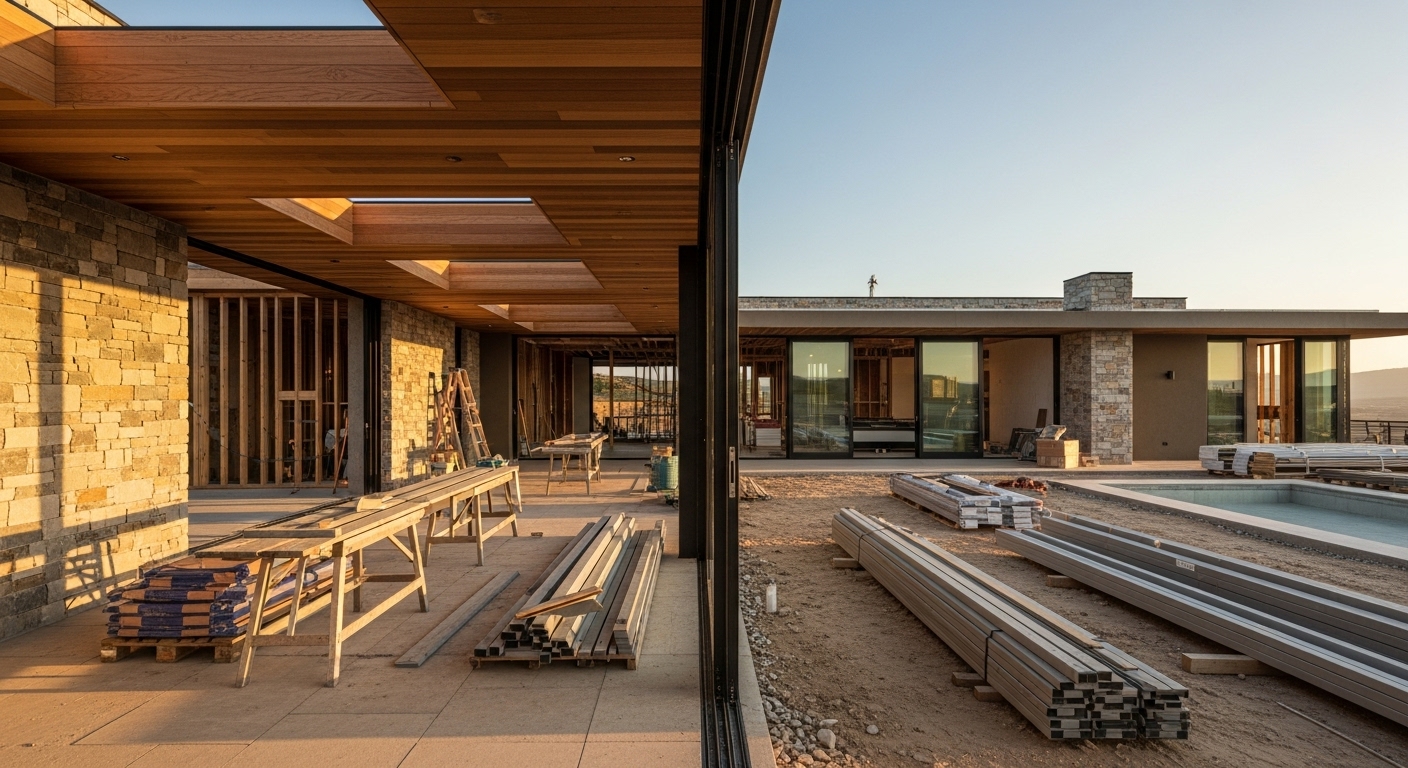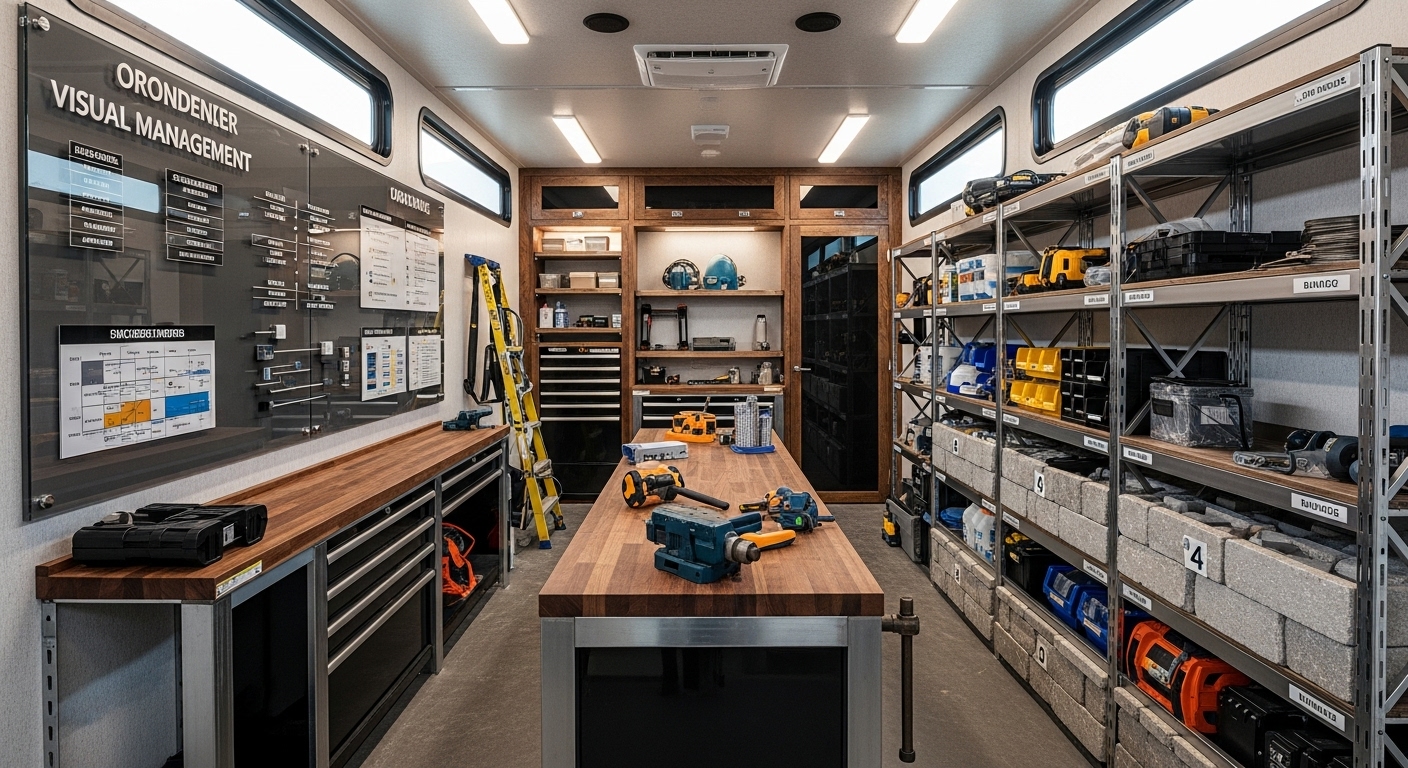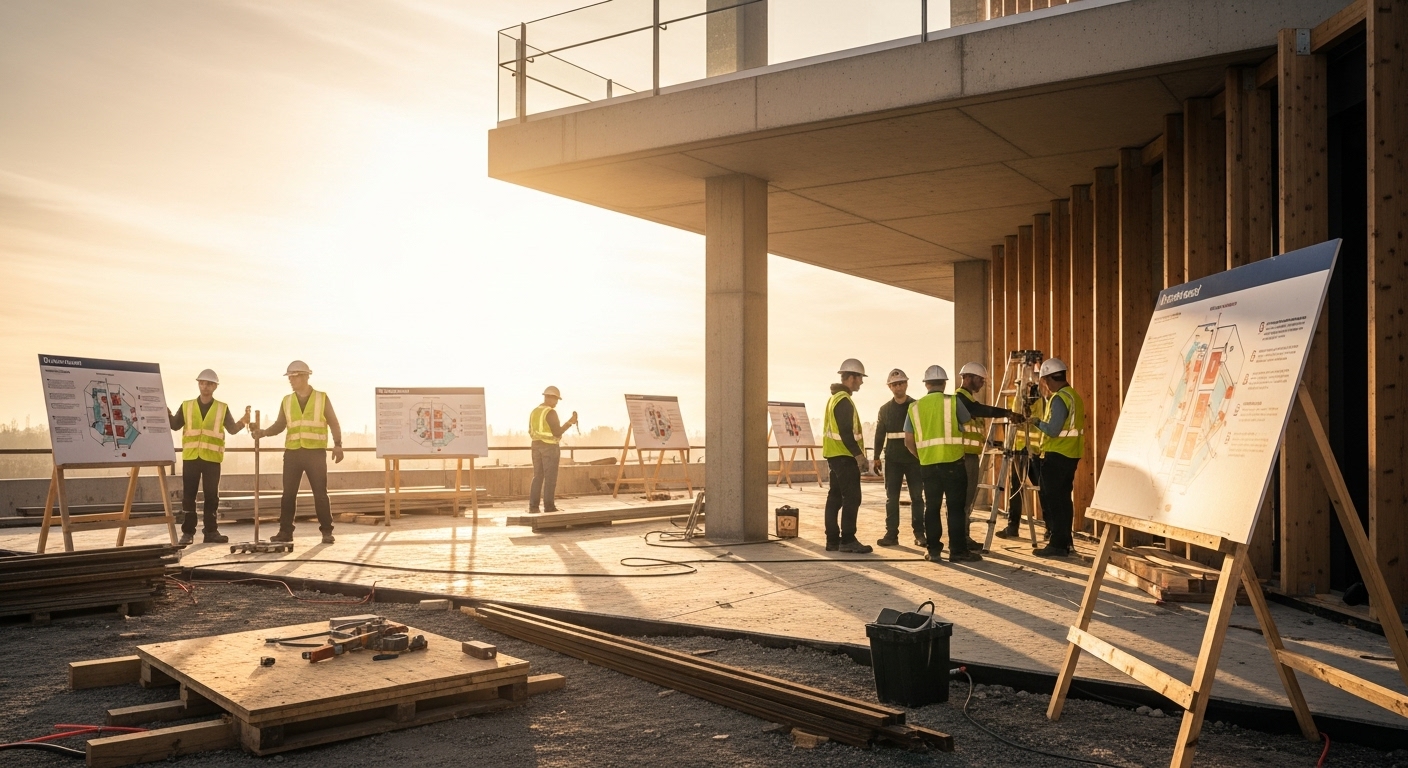July 27, 2025 by 100XBuilds Team
Lean Principles for Luxury Builders: Cut Waste & Boost ROI

When Toll Brothers implemented lean principles across their luxury home building operations, they reduced construction cycle times by 23% while cutting material waste by $2.3 million annually. This wasn't achieved through corner-cutting or compromising quality—it was the result of systematically eliminating waste and optimizing every process from design to delivery.
For luxury home builders generating $5M+ annually, operational inefficiencies aren't just costly—they're reputation killers. When a $2.8 million custom home experiences delays due to rework, material shortages, or coordination failures, the financial impact extends far beyond immediate costs to include client dissatisfaction, referral losses, and brand damage.
The Hidden Cost of Operational Waste in Luxury Construction
Most luxury builders unknowingly operate with 25-40% waste embedded in their processes. This waste manifests in eight distinct forms that directly impact your bottom line:
Overproduction: Building components before they're needed, leading to storage costs and potential damage
Waiting: Crews standing idle due to material delays, permit issues, or coordination failures
Transportation: Excessive movement of materials, tools, and personnel across job sites
Over-processing: Performing work beyond client specifications or industry standards
Inventory excess: Stockpiling materials that tie up capital and risk obsolescence
Motion waste: Inefficient worker movements due to poor site organization
Defects: Rework, callbacks, and quality issues that damage reputation
Underutilized talent: Skilled craftsmen performing tasks below their capability level
A typical $3.5 million luxury home project experiences an average of 47 days in delays, with 68% attributed to these waste categories. The financial impact? An average of $127,000 in additional costs per project when factoring in extended overhead, financing costs, and opportunity losses.
Implementing Lean Principles: The 5S Foundation
The journey toward operational excellence begins with 5S—a systematic approach to workplace organization that creates the foundation for all other lean improvements.
Sort (Seiri): Eliminate the Unnecessary
Begin by conducting a comprehensive audit of every job site, warehouse, and office space. Remove items that haven't been used in the past 30 days, creating designated areas for tools, materials, and equipment based on frequency of use.
Implementation metrics:
- Reduce tool search time by 40-60%
- Decrease material handling by 25%
- Improve safety incident rates by 35%
Set in Order (Seiton): Organize for Efficiency
Create visual management systems where every item has a designated location. Implement shadow boards for tools, color-coded storage systems for materials, and standardized layouts across all job sites.
Key strategies:
Visual controls: Use floor markings, signs, and color coding to guide workflow
Standardized layouts: Implement consistent site organization across all projects
Point-of-use storage: Position materials and tools where they're needed most

Shine (Seiso): Maintain Cleanliness Standards
Establish daily cleaning routines that go beyond basic housekeeping. Clean job sites reveal problems faster—oil leaks indicate equipment issues, debris accumulation signals workflow problems, and disorganization points to process breakdowns.
Standardize (Seiketsu): Create Consistent Processes
Document and standardize the first three S's across all projects. Create checklists, standard operating procedures, and visual guides that ensure consistency regardless of crew composition or project location.
Sustain (Shitsuke): Build Continuous Improvement Culture
Implement regular audits, recognition programs, and feedback loops that maintain momentum. Track metrics weekly and celebrate improvements to reinforce behavioral changes.
Value Stream Mapping: Visualizing Your Construction Process
Value stream mapping reveals the flow of materials and information from project initiation to client handover. This exercise typically uncovers 15-25% waste in luxury construction processes.
Current State Analysis
Map every step in your construction process, including:
Lead times: Time between process steps
Processing times: Actual work being performed
Quality rates: Percentage of work completed correctly first time
Changeover times: Setup and transition periods between activities
Inventory levels: Materials waiting between processes
A luxury builder in Colorado discovered their permit approval process averaged 23 days, with only 4.5 hours of actual processing time. The remaining time was pure waste—documents sitting in queues, waiting for approvals, or being transferred between departments.
Future State Design
Design your ideal process flow by eliminating identified waste. Focus on:
Continuous flow: Minimize work-in-progress inventory
Pull systems: Produce only what's needed when it's needed
Takt time alignment: Match production pace to client demand
Error-proofing: Build quality into processes rather than inspecting it in

Implementing Pull Systems in Construction
Traditional construction operates on push systems—materials arrive based on schedules rather than actual need. Pull systems revolutionize this approach by triggering material delivery and work initiation only when the previous step is complete and ready.
Kanban Implementation
Implement visual signals that trigger material replenishment and work authorization:
Two-bin system: When one material bin empties, it signals reorder time
Digital kanban boards: Real-time visibility into work status and material needs
Supplier integration: Direct connection between job site consumption and supplier delivery
A luxury builder in Texas reduced material inventory by 35% while improving material availability to 98.7% through kanban implementation. Their average material carrying costs dropped from $47,000 per project to $31,000.
Just-in-Time Delivery
Coordinate with suppliers to deliver materials precisely when needed:
Delivery windows: 2-4 hour windows rather than full-day ranges
Sequence delivery: Materials arrive in order of installation
Quality pre-checks: Supplier inspection before delivery to eliminate defects
Standardized Work: The Foundation of Consistency
Standardized work eliminates variation in how tasks are performed, creating predictable outcomes and identifying improvement opportunities.
Work Instruction Development
Create detailed, visual work instructions for critical processes:
Takt time: Optimal pace for each task
Work sequence: Specific order of operations
Standard inventory: Exact materials and tools required
Quality checkpoints: Inspection criteria and timing
Implementation Strategy
Pilot testing: Start with high-impact, repetitive processes
Crew involvement: Include experienced craftsmen in standard development
Continuous refinement: Update standards based on improvement suggestions
Training integration: Incorporate standards into all crew training programs
A luxury builder in California standardized their electrical rough-in process, reducing installation time from 3.2 days to 2.1 days while improving first-pass quality rates from 87% to 96%.

Mistake-Proofing (Poka-Yoke) in Construction
Error-proofing prevents defects from occurring rather than catching them after the fact. In luxury construction, where rework costs average $23,000 per incident, prevention is crucial.
Physical Mistake-Proofing
Jigs and fixtures: Ensure consistent placement and alignment
Color coding: Prevent incorrect material selection
Size differentiation: Make wrong choices physically impossible
Checklists: Systematic verification of critical steps
Process Mistake-Proofing
Sequential dependencies: Prevent next step until current step is verified complete
Automatic stops: Halt processes when parameters exceed acceptable ranges
Redundant checks: Multiple verification points for critical quality attributes
Visual indicators: Immediate feedback on process status and quality
Continuous Improvement Through Kaizen Events
Kaizen events are focused improvement workshops that generate rapid results. These intensive sessions typically produce 20-30% improvements in targeted processes within one week.
Event Structure
Day 1: Current state analysis and problem identification
Days 2-3: Root cause analysis and solution development
Days 4-5: Implementation and testing
Follow-up: 30-60-90 day progress reviews
Success Metrics
Track improvements across multiple dimensions:
Efficiency gains: Cycle time reduction, productivity increases
Quality improvements: Defect reduction, rework elimination
Safety enhancements: Incident reduction, hazard elimination
Cost savings: Material waste reduction, labor optimization
A luxury builder in Florida conducted monthly kaizen events, achieving cumulative improvements of 34% in construction cycle time and 28% reduction in material waste over 18 months.

Technology Integration for Lean Operations
Modern technology amplifies lean principles by providing real-time visibility, automating waste identification, and enabling rapid response to problems.
Digital Visual Management
Real-time dashboards: Project status, quality metrics, and performance indicators
Mobile applications: Instant access to standards, checklists, and reporting tools
IoT sensors: Automatic monitoring of equipment, materials, and environmental conditions
Drone surveillance: Aerial progress monitoring and quality verification
Predictive Analytics
Leverage data to prevent problems before they occur:
Material consumption patterns: Predict shortages before they impact schedules
Equipment maintenance: Schedule maintenance based on usage patterns rather than calendar dates
Quality trend analysis: Identify process drift before defects occur
Schedule optimization: Dynamic scheduling based on real-time conditions
Measuring Lean Implementation Success
Establish comprehensive metrics that track both leading and lagging indicators of operational excellence:
Financial Metrics
Cost per square foot: Track reduction in construction costs
Profit margin improvement: Measure bottom-line impact
Working capital efficiency: Monitor inventory turns and cash flow
Return on invested capital: Overall financial performance improvement
Operational Metrics
Cycle time reduction: Time from start to completion
First-pass quality: Percentage of work completed correctly initially
Schedule adherence: Percentage of milestones met on time
Material waste percentage: Waste as percentage of total material costs
Client Satisfaction Metrics
Net Promoter Score: Client willingness to recommend your services
Callback frequency: Post-completion service requests
Change order rates: Percentage of projects with scope changes
Delivery performance: On-time completion rates
Building a Lean Culture
Sustainable lean implementation requires cultural transformation that engages every team member in continuous improvement.
Leadership Commitment
Gemba walks: Regular leadership presence on job sites
Resource allocation: Dedicated time and budget for improvement activities
Recognition programs: Celebrate improvement contributions
Training investment: Comprehensive lean education for all team members
Employee Engagement
Suggestion systems: Formal processes for improvement ideas
Problem-solving training: Equip crews with analytical tools
Cross-training programs: Develop versatile, adaptable workforce
Communication systems: Regular updates on improvement progress and results

Overcoming Implementation Challenges
Lean transformation faces predictable obstacles that require proactive management:
Resistance to Change
Communication strategy: Clearly explain benefits and address concerns
Pilot successes: Demonstrate value through small-scale wins
Involvement approach: Include skeptics in improvement activities
Patience and persistence: Allow time for cultural adaptation
Resource Constraints
Phased implementation: Prioritize high-impact improvements
External support: Leverage lean consultants for expertise and acceleration
Training efficiency: Use internal champions to multiply learning
ROI focus: Emphasize improvements that generate quick returns
The Path Forward: Your Lean Implementation Roadmap
Successful lean transformation follows a structured approach that builds momentum through early wins while establishing foundations for long-term success.
Start with 5S implementation across one pilot project, measuring improvements in tool search time, material handling efficiency, and safety incidents. Use these results to build credibility and secure resources for broader implementation.
Next, conduct value stream mapping for your most common project type, identifying the top three waste sources and implementing targeted improvements. Track cycle time reduction and cost savings to demonstrate value.
Expand standardized work development to critical processes, beginning with those that show highest variation or quality issues. Measure consistency improvements and use success stories to drive adoption.
The luxury construction market demands operational excellence—clients expect flawless execution, predictable timelines, and exceptional quality. Lean principles provide the systematic approach to deliver these expectations while improving profitability and competitive advantage.
Your operational transformation starts with a single step. Choose one process, apply lean principles systematically, and measure results rigorously. The compound effect of continuous improvement will revolutionize your construction operations and establish your reputation as the premier luxury builder in your market.
Ready to eliminate waste and optimize your construction operations? Contact 100XBuilds today to develop your customized lean implementation strategy and join the ranks of luxury builders achieving operational excellence through systematic improvement.
